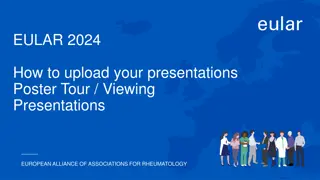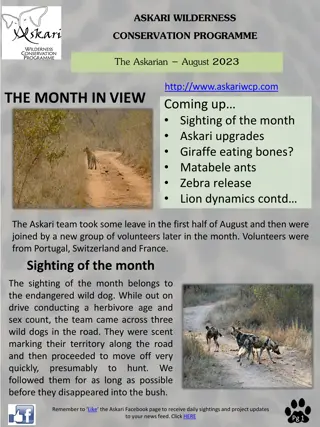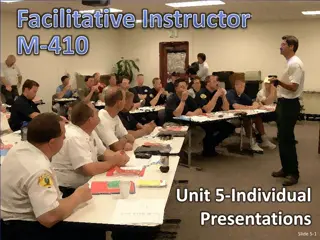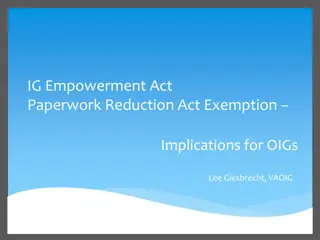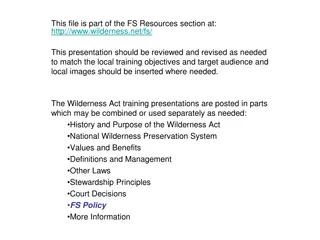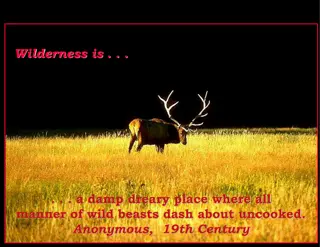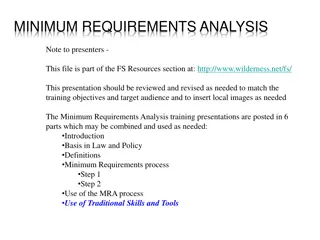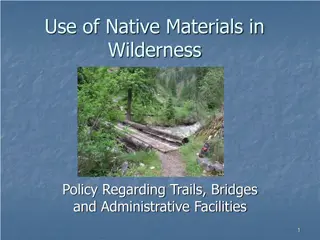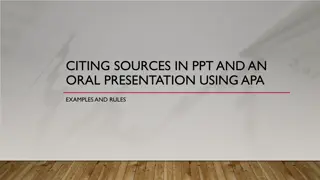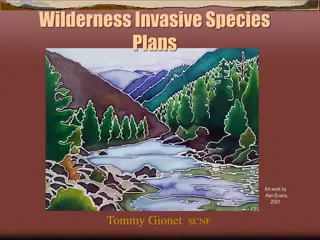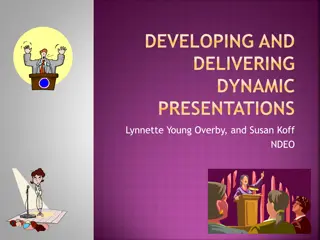Understand Wilderness Act Training Presentations
Review and revise the Wilderness Act training presentations to align with local training goals and audience. Incorporate relevant images and cover topics like history, values, stewardship, court decisions, and more. Explore legal cases emphasizing the preservation of wilderness character in various jurisdictions.
Download Presentation

Please find below an Image/Link to download the presentation.
The content on the website is provided AS IS for your information and personal use only. It may not be sold, licensed, or shared on other websites without obtaining consent from the author.If you encounter any issues during the download, it is possible that the publisher has removed the file from their server.
You are allowed to download the files provided on this website for personal or commercial use, subject to the condition that they are used lawfully. All files are the property of their respective owners.
The content on the website is provided AS IS for your information and personal use only. It may not be sold, licensed, or shared on other websites without obtaining consent from the author.
E N D
Presentation Transcript
This file is part of the FS Resources section at: http://www.wilderness.net/fs/ This presentation should be reviewed and revised as needed to match the local training objectives and target audience and local images should be inserted where needed. The Wilderness Act training presentations are posted in parts which may be combined or used separately as needed: History and Purpose of the Wilderness Act National Wilderness Preservation System Values and Benefits Definitions and Management Other Laws Stewardship Principles Court Decisions FS Policy More Information
preserve wilderness character BWCAW Superior NF Izaak Walton League v. Kimbell (D. Minn.) (2007) ...an agency s duty to preserve wilderness character may apply to agency activity that occurs outside the boundaries . The key questions in determining whether agency action violates 4(b) is whether that action degrades the wilderness character
preserve wilderness character Outfiter-guide operations in wilderness Inyo and Sierra NFs High Sierra Hikers v. Blackwell (9thCir.) (2004) Balance: Types of activities Need for services in wilderness, not demand Amount of use the land can tolerate - capacity BUT overarching purpose is to preserve wilderness character, unimpaired for future use and enjoyment.
preserve wilderness character Caribou-Targhee National Forests Heli-skiing in area recommended for wilderness Greater Yellowstone Coalition vs. Timchak (D.Idaho) (2006)
preservation of wilderness dominates Road Access to In-holding Absaroka-Beartooth Wilderness Gallatin NF Absaroka Trust vs. Glickman (D. Mont.) (2002)
preserve wilderness character Barnes v. Babbitt (D. Ariz.) (2004) The W. Act requires the BLM to preserve the wilderness character and [to] so administer such area for such other purposes as also to preserve its wilderness character. Because of character of wilderness, non-motorized access is adequate
State Authority for Management of Fish and Wildlife in Wilderness 10thAmendment Geer v. Connecticut (1896) Wilderness Act, 4(d)(8) 43 CFR 24.3(b)
Kleppe v. New Mexico (1976) Congress complete authority over the public lands includes the power to regulate and protect the wildlife living there. The Property Clause gives Congress the power to protect wildlife on the public lands, state law notwithstanding. Where state laws conflict with legislation passed pursuant to the Property Clause, the law is clear: The State laws must recede.
Hughes v. Oklahoma (1979) The cases defining the scope of permissible state regulation in areas of congressional silence reflect an often controversial evolution of rules to accommodate federal and state interests. Geer v. Connecticut is overruled. Time has revealed the error of the result reached in Geer through its application of the 19thcentury legal fiction of state ownership of wild animals.
Hunt v. U.S. (1928) The power of the United States to protect its lands and property does not admit of doubt, the game laws or any other statute of the state to the contrary notwithstanding.
Wyoming v. U.S. (2002) State trustee and police powers over the wildlife found on Federal lands are not constitutionally-based. In view of [Kleppe], we believe the point painfully apparent that the Tenth Amendment does not reserve to the State the right to manage wildlife. The State does not have the sovereign power to manage wildlife on Federal lands.
Wyoming v. U.S. (2002) We must not be guided by a single sentence but to look to the provisions of the whole law. By establishing a system to administer a national network of lands and waters , Congress undoubtedly intended a preeminent federal role. The saving clause does not deny the [Federal agency], where at odds with the State, the authority to make a binding decision.
Wyoming v. U.S. (2002) Federal management and regulation preempts state management and regulation to the extent the two actually conflict, or where state management and regulation stands as an obstacle to the accomplishment of the full purposes and objectives of the Federal Government.



